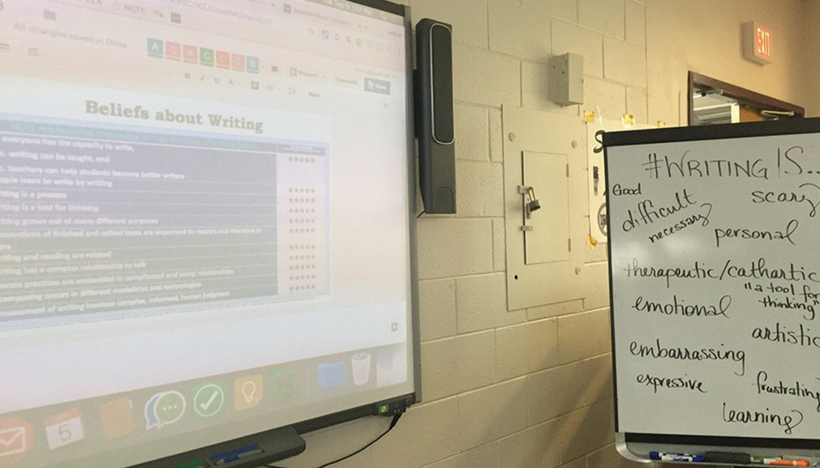This post by NCTE member Lara Searcy first appeared 1/13/18.
“Personal. Frustrating. Necessary. Scary. Emotional. Expressive. Embarrassing.” Ultimately, writing is a learning experience that brings about a myriad of emotions—in students and in teachers. When I ask my students, “What is writing?,” their answers (above) reveal a lot about their personal writing identity—an identity many do not have. This question provides the first crucial conversation I have with my students, because for me, a teacher of writing, I commit to the belief that “everyone has the capacity to write, writing can be taught, and teachers can help students become better writers” (NCTE, 2016). But first, my students must believe that “they have the capacity to write, writing can be learned, and that I can help them become a better writer” (NCTE, 2016).
As teachers of writing, we must help navigate the conversation about what writing is, taking it from being an emotional question often filled with loaded adjectives to a professional responsibility where students are given context for why and how we write. To help begin this conversation, I use NCTE’s Professional Knowledge about the Teaching of Writing Statements (2016) as a way to seek out guidance, teaching context (Each section of the statement includes “What does this mean for teaching?”), and related resources to support my course’s essential question: “How do critical reading and critical writing promote critical thinking?” To answer this question, my students must become readers, writers, and thinkers, and I must adhere to “professional principles that guide effective teaching” (NCTE, 2016). Therefore, the Statements provide valuable initial insight about my students’ “beliefs about writing” (as the 2004 version of the Statements were called).
For each statement/belief, I have students rate their level of agreement using a star Likert-scale. If they strongly agree with the statement/belief, five stars; if they are indifferent about it, three stars; and if they disagree with it, one star. This self-assessment requires students to reflect on their prior experiences with writing but also provides an expanding knowledge of what writing can be. After rating the statements/beliefs, I then have students rank the beliefs in order of importance to them, which allows for more reflection on writing’s role and importance. At this point, I create a whole-group ranking chart and we discuss our reasoning and review each statement/belief:
1) Writing grows out of many purposes. Writing can be mode specific, but it is always shaped by the author’s purpose, audience, and context. Knowing purpose provides focus.
2) Writing is embedded in complex social relationships, which means there is a relationship between the writer and the reader. This creates community, and the language the writer uses defines culture.
3) Writing occurs in different modalities and technologies. Essentially, opportunities to compose expand with the broader audience that technology provides.
4) Conventions of finished and edited texts are an important dimension of the relationship between writers and readers. This means that there is an expectation of style, and conventions are best taught in the context of writing.
5) Everyone has the capacity to write, writing can be taught, and teachers can help students become better writers. How does this happen? By writing!
6) Writing is a process. Students need to understand that reading, writing, and thinking are all critical and recursive processes.
7) Writing is a tool for thinking. Often, reluctant students gain confidence in their thoughts by first articulating them through writing.
8) Writing has a complex relationship to talk. Speaking and listening are at the heart of the writing process because writing exists in an environment of talk.
9) Writing and reading are related, which is why writing is often the output of the reading input. Reading informs our writing and often provides the input of ideas.
10) The assessment of writing involves complex, informed, human judgment. Writing needs to be evaluated (in process) in a way that supports a writer and grows their efficacy.
The discussions about each statement/belief help to establish a safe classroom community that now has a common understanding of what writing is, when before the classroom environment may have been associated with emotional adjectives such as scary, difficult, or embarrassing. Also, students are able to begin developing their writing identities because they have defined who they are and can now articulate what writing is to them. Therefore, the Statements not only aid in my professional knowledge about the teaching of writing, as they were intended to be used, but they anchor crucial conversations I have with my students about what writing is—an important output for acquiring, refining, and sharing knowledge (NCTE, 2016). As you begin or continue your semester, consider asking yourself and your students “What is writing?” Then enjoy the discovery of how that definition changes throughout the year as you seek to cultivate a classroom that strengthens and celebrates unique writing identities.
References
National Council of Teachers of English (NCTE). (2016, Feb. 28)Professional knowledge for the teaching of writing. Retrieved from www2.ncte.org/statement/teaching-writing/.
 Lara Searcy is the English Education Specialist at Northeastern State University in Tahlequah, Oklahoma, where she prepares future English teachers and teaches English methods, composition, and advanced composition courses. She is a former high school English teacher and is currently a PhD candidate in Curriculum and Instruction at the University of Arkansas.
Lara Searcy is the English Education Specialist at Northeastern State University in Tahlequah, Oklahoma, where she prepares future English teachers and teaches English methods, composition, and advanced composition courses. She is a former high school English teacher and is currently a PhD candidate in Curriculum and Instruction at the University of Arkansas.


